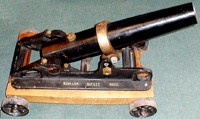The Lyle Gun – Breeches Buoy Lifesaving System

The Lyle Gun
A ship is foundering off the coast – lives are at risk, crewmen must be rescued. That job falls to the surf men of the U.S. Coast Guard, and prior to 1915, to its predecessor, the U.S. Life-Saving Service. In situations where the stricken vessel is within a few hundreds yards from shore, it is possible to effect a rescue without putting a rescue craft in the water and needlessly risking the lives of the rescuers. In such cases, a line is launched from shore to the vessel. Today a rocket fires that line. Prior to 1952, a small cannon, a line-throwing gun, was used.
A line-throwing gun is a short-barreled cannon designed to fire a projectile attached to a rope to a boat or victim in distress. Experiments in shooting tethered projectiles dates back to around 1800. A mortar device was credited with saving lives in 1850. But it wasn’t until West Point and MIT graduate Army Captain David A. Lyle (1845 – 1937) began his research and testing that resulted in reliable efficient designs.

Thus line-throwing guns are most often referred to as “Lyle Guns.” The U.S. government funded many line throwing gun projects. There were about 30 companies who made line-throwing guns from the late 1800’s to 1952. Famous names included, American Manufacturing, Galbraith, General Ordnance, Naval Company, Sculler and Steward. Production ceased in 1952 in favor of rockets.
These line guns are used primarily for shore based rescue operations. The shooter would fire, aiming over the victims’ heads and then pull the line within reach of the victims. They are also useful for rescuing victims that have fallen through the ice, or are stranded on a cliff or burning building.
Boats in distress need larger lines. Lyle guns were designed to throw projectiles weighing approximately 18 pounds, carrying heavier rope to ranges as great as 700 yards. Once the line was fired to the ship, shore crews sent out breeches buoy equipment and instructions to the stranded sailors. Once the breeches buoy lines were assembled, the sailors could be removed from the vessel.

Breeches Bouy
Standard procedure was for line throwing guns and breeches buoys to be used for wrecks within 600 yards of the shore; rescues at greater distances were to be accomplished by lifeboats.

